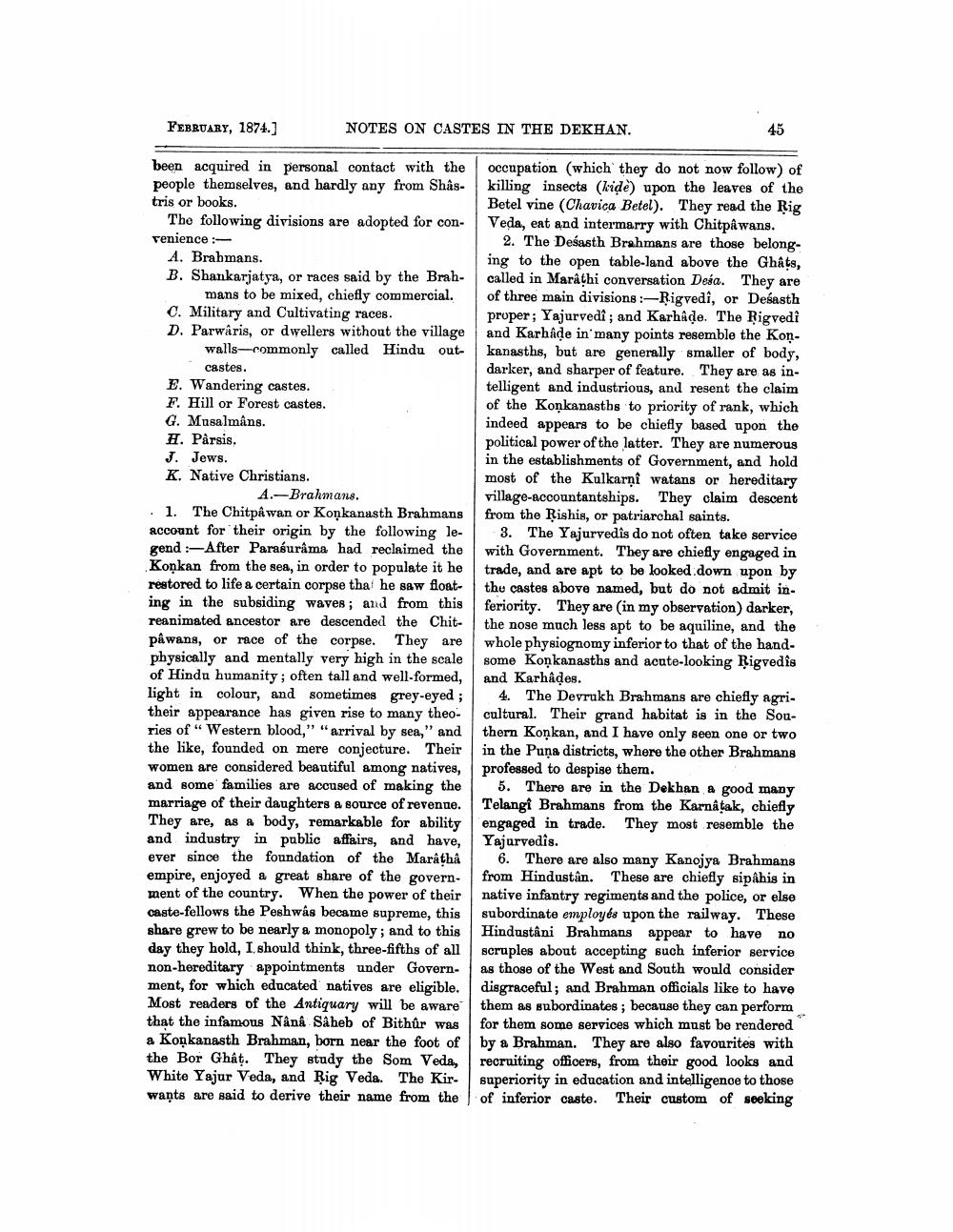________________
FEBRUARY, 1874.)
NOTES ON CASTES IN THE DEKHAN.
45
been acquired in personal contact with the people themselves, and hardly any from Shâstris or books.
The following divisions are adopted for convenience:
A. Brahmans. B. Shankarjatya, or races said by the Brah
mans to be mixed, chiefly commercial. C. Military and Cultivating races. D. Parwaris, or dwellers without the village
walls-commonly called Hindu out
castes. E. Wandering castes. F. Hill or Forest castes. G. Musalmans. H. Pårsis. J. Jews. K. Native Christians.
A.-Brahmans. . l. The Chitpawan or Koņkanasth Brahmans account for their origin by the following legend :- After Parasurama had reclaimed the Konkan from the sea, in order to populate it he restored to life a certain corpse that he saw floating in the subsiding waves; and from this reanimated ancestor are descended the Chitpâwang, or race of the corpse. They are physically and mentally very high in the scale of Hindu humanity; often tall and well-formed, light in colour, and sometimes grey-eyed ; their appearance has given rise to many theo. ries of " Western blood," "arrival by sea," and the like, founded on mere conjecture. Their women are considered beautiful among natives, and some families are accused of making the marriage of their daughters a source of revenue. They are, as a body, remarkable for ability and industry in public affairs, and have, ever since the foundation of the Maratha empire, enjoyed a great share of the govern. ment of the country. When the power of their caste-fellows the Peshwas became supreme, this share grew to be nearly a monopoly; and to this day they hold, I should think, three-fifths of all non-hereditary appointments under Government, for which educated natives are eligible. Most readers of the Antiquary will be aware that the infamous Nânâ Saheb of Bithûr was a Konkanasth Brahman, born near the foot of the Bor Ghat. They study the Som Veda, White Yajur Veda, and Rig Veda. The Kir. wants are said to derive their name from the
occupation (which they do not now follow) of killing insects (kide) upon the leaves of the Betel vine (Chavica Betel). They read the Rig Veda, ent and intermarry with Chitpawans.
2. The Desasth Brahmans are those belong. ing to the open table-land above the Ghâts, called in Marathi conversation Desa. They are of three main divisions :-Rigvedî, or Desasth proper; Yajurvedî; and Karháde. The Rigvedi and Karh Ade in many points resemble the Konkanasths, but are generally smaller of body, darker, and sharper of feature. They are as intelligent and industrious, and resent the claim of the Konkanasths to priority of rank, which indeed appears to be chiefly based upon the political power of the latter. They are numerous in the establishments of Government, and hold most of the Kulkarņi watans or hereditary village-accountantships. They claim descent from the Rishis, or patriarchal saints.
3. The Yajurvedis do not often take service with Government. They are chiefly engaged in trade, and are apt to be looked down upon by thu castes above named, but do not admit in. feriority. They are in my observation) darker, the nose much less apt to be aquiline, and the whole physiognomy inferior to that of the handsome Konkanasths and acute-looking Rigvedis and Karhâdes.
4. The Devrukh Brahmans are chiefly agricultural. Their grand habitat is in the Southern Konkan, and I have only seen one or two in the Puna districts, where the other Brahmans professed to despise them.
5. There are in the Dekhan a good many Telangi Brahmans from the Karnatak, chiefly engaged in trade. They most resemble the Yajurvedis.
6. There are also many Kanojya Brahmans from Hindustan. These are chiefly sipahis in native infantry regiments and the police, or else subordinate employés upon the railway. These Hindustani Brahmans appear to have no scruples about accepting such inferior service as those of the West and South would consider disgraceful; and Brahman officials like to have them as subordinates; because they can perform for them some services which must be rendered by a Brahman. They are also favourites with recruiting officers, from their good looks and superiority in education and intelligence to those of inferior caste. Their custom of seeking




